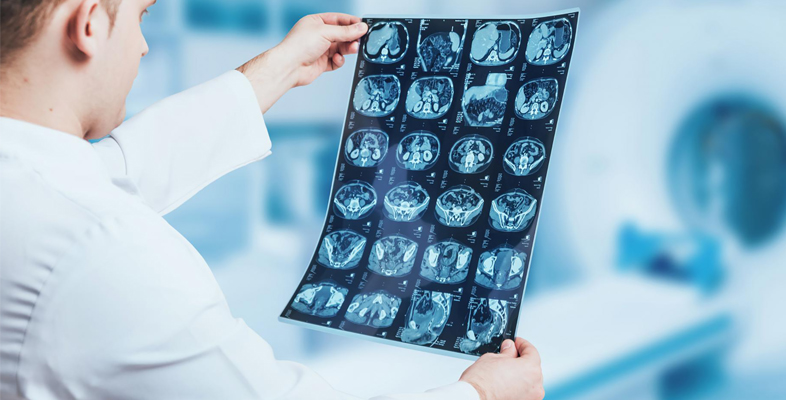Gadolinium complexes
Figure 14 shows an example of the marked improvement in the quality of the MRI data when a gadolinium contrast agent is used.
The complex is delivered to the patient intravenously and is carried round in the blood plasma but does not enter the cells. Considering the example of the brain, gadolinium complexes cannot cross the blood–brain barrier in a normal brain. However, in Figure 14 a tumour is present; this causes the blood–brain barrier to become ‘leaky’ and thus allows the contrast agent to cross into the brain.

Now, before moving on to look at some specific gadolinium complexes, consider what you should be looking for in a ligand by having a go at the following questions.
To get round the toxicity issue mentioned in the previous section, is in the form of a complex – one that will not dissociate. You saw earlier that chelating ligands form particularly stable complexes, and indeed these are used here.
-
What factor will influence the choice of ligand for a contrast agent?
-
The ligand should form a complex with a high stability constant. This can be influenced by the choice of polydentate ligands, ligand preorganisation and/or the choice of correct ligating atoms.
-
Why do chelating ligands lead to greater stability compared with a simple monodentate ligand – say, NH3?
-
Complexes containing polydentate (chelating ligands) are particularly stable. Several factors contribute, but it is thought that the most influential is the entropy change in the formation reaction. The entropy change for the chelated complex is positive, whereas that for the complex with no chelate rings is negative.
-
Which coordinating atoms would be preferred for binding?
-
is a hard acid, so is likely to coordinate to hard bases such as O or N atoms.
The first gadolinium complex to be used clinically, in 1988, was Magnevist®, a nine-coordinate complex of gadolinium(III), .
The DTPA ligand is diethylenetriaminepentaacetate (ethanoate), shown as the protonated form in Structure 2.

DTPA is an octadentate ligand, with coordination by all five carboxylate groups and the three nitrogen atoms. A ninth coordination site on gadolinium is occupied by a water ligand (remember – high coordination numbers are common for lanthanide ions).
-
What type of ligand is H2O in this structure?
-
It is an inner-sphere ligand as it is attached directly to the metal.
This is the water molecule that undergoes ligand exchange with bulk water.
This Gd(III) complex has since been followed by others, shown in Figure 15.

-
What do you notice about the charges on these ligands?
-
These ligands are anionic.
The negative charge will promote binding to the metal cation. In addition, an anionic complex will have greater interactions with outer-sphere water.
And, as is characteristic of the lanthanides, gadolinium being a very large atom can accommodate a large number of ligands. A single octadentate ligand such as DTPA ensures that there is not room for many water ligands to coordinate, as too many water ligands may make the complex too reactive.
A further consideration is the rate at which the contrast agent rotates or tumbles in solution.
A slow rotation rate can reduce relaxation times, although the relationship between rotation rate and relaxation rates is complex. One line of research is to use large molecules such as proteins as ligands, which tumble slowly in solution. Another possibility is to use antibodies as ligands to improve tissue targeting.
-
Why is not a suitable ligand for gadolinium coordination in a 1 : 1 metal–ligand complex?
-
As a hexadentate ligand, alone will not saturate all the coordination shell in a 1 : 1 complex. This will leave room for other ligands, such as water, to coordinate.
In this first part of the course you have seen the role that metals play in medical imaging. In the next two sections you will look at metal containing compounds as drugs.
